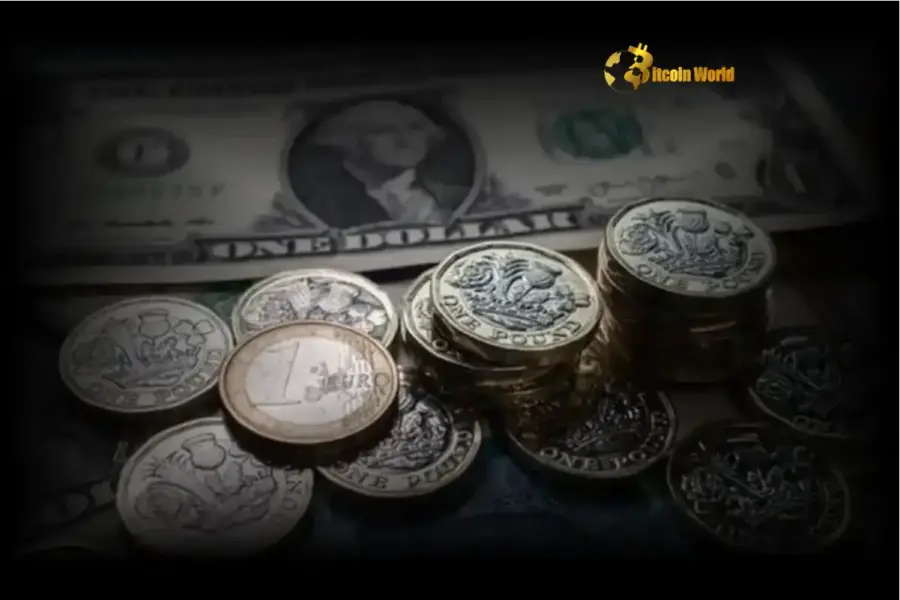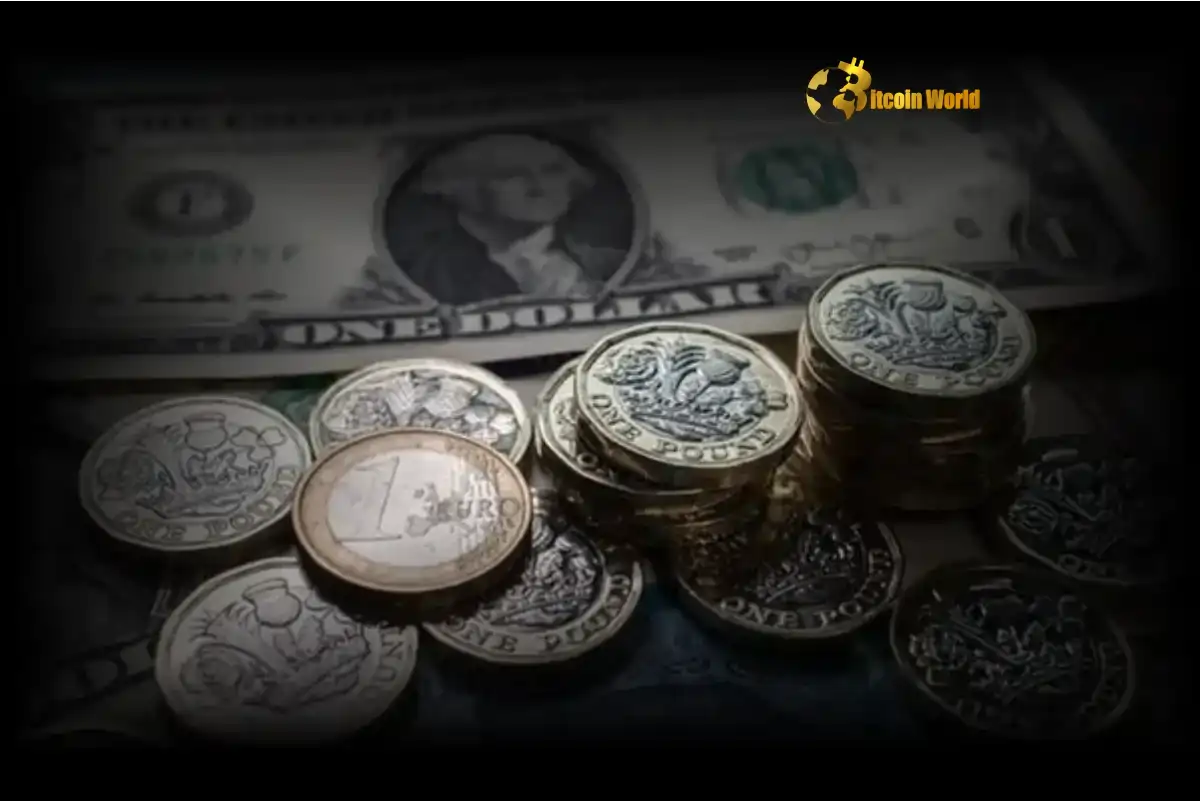Dramatic US Dollar Fall: Sterling Gains Amid Inflation Rise, What it Means for Crypto
0
0

BitcoinWorld

Dramatic US Dollar Fall: Sterling Gains Amid Inflation Rise, What it Means for Crypto
Welcome back to the intersection of global finance and digital assets. For those tracking the cryptocurrency markets, understanding broader macroeconomic trends is crucial. Recently, significant shifts in the traditional Forex market have caught the attention of investors worldwide. Specifically, the US Dollar has been experiencing a notable decline, while the British Sterling has shown unexpected strength, largely driven by recent economic data. How do these currency movements affect the world of Bitcoin and altcoins? Let’s dive in.
Why is the US Dollar Losing Ground?
The world’s primary reserve currency, the US Dollar, has been on a downward trajectory against several major peers. Several factors contribute to this trend:
- Changing Interest Rate Expectations: Market participants are increasingly betting that the US Federal Reserve might be nearing the end of its aggressive rate-hiking cycle, or could even consider cuts sooner than previously thought. Lower expected interest rates can make a currency less attractive to foreign investors seeking yield.
- Inflation Dynamics: While US inflation has moderated from its peaks, the pace of decline and future expectations play a role. If other countries’ inflation remains higher or their central banks signal more hawkish stances, their currencies can gain relative to the dollar.
- Global Economic Outlook: A weakening global economy can sometimes strengthen the dollar as a safe-haven asset. Conversely, signs of resilience elsewhere can reduce demand for the dollar.
- Fiscal and Political Factors: Issues like the US debt ceiling debates or large fiscal spending packages can also influence sentiment around the dollar’s stability and value.
Understanding these drivers behind the falling US Dollar is key to interpreting broader market sentiment.
What’s Fueling Sterling‘s Surge?
In contrast to the weakening dollar, the British Sterling has demonstrated surprising resilience, particularly following the latest inflation data from the UK. Here’s why:
- Stubbornly High UK Inflation: The UK has been grappling with persistent and elevated inflation, which has remained higher than in many comparable economies, including the US and Eurozone.
- Bank of England’s Stance: High inflation puts pressure on the Bank of England (BoE) to continue raising interest rates to bring price pressures under control. The expectation of further rate hikes makes owning Sterling-denominated assets more appealing, boosting demand for the currency.
- Economic Data: While the UK economy faces challenges, recent data points, particularly on inflation, have reinforced the view that the BoE has more work to do on monetary tightening.
The contrast between the expected paths of the Federal Reserve and the Bank of England is a primary driver of the divergent performance between the US Dollar and Sterling.
Forex Market Dynamics: A Tale of Two Currencies
The recent movements in the Forex market highlight how relative economic performance and central bank policies dictate currency values. It’s not just about a currency weakening in isolation; it’s often about how it performs relative to others. The dynamic between the US Dollar and Sterling is a prime example of this relative strength and weakness based on differing inflationary pressures and monetary policy outlooks.
Consider the comparison:
US Dollar Factors:
- Inflation showing signs of cooling.
- Fed potentially pausing or nearing end of hiking cycle.
- Market pricing in potential future rate cuts.
Sterling Factors:
- Inflation UK remaining stubbornly high.
- BoE expected to continue raising rates.
- Market pricing in further tightening.
This divergence creates opportunities and challenges across global financial markets.
Does a Weak Dollar Boost Crypto Impact?
Now, let’s connect these traditional finance movements to the digital asset space. The relationship between the US Dollar and cryptocurrency is complex but significant:
- Stablecoin Dominance: The vast majority of stablecoins are pegged to the US Dollar (e.g., USDT, USDC). A weakening dollar means that the purchasing power of these stablecoins, and thus the base value of many crypto trades, is also slightly eroding relative to other assets or currencies.
- Risk-On vs. Risk-Off Sentiment: A falling dollar can sometimes coincide with a broader ‘risk-on’ sentiment in global markets. When investors move away from safe-haven assets like the dollar, they may look towards riskier assets, including cryptocurrencies. This can lead to increased capital flows into the crypto market.
- Inflation Hedge Narrative: The original narrative for Bitcoin often included its potential as a hedge against inflation and currency debasement. While this narrative has been debated, a weakening dollar due to inflationary concerns can sometimes rekindle interest in Bitcoin as an alternative store of value, potentially boosting its price and the broader Crypto impact.
- Global Capital Flows: As investors react to currency shifts, capital flows move across borders and asset classes. A less attractive dollar might see funds diverted into other global markets or alternative assets like crypto.
While not a direct one-to-one correlation, a persistent trend of US Dollar weakness can create tailwinds for the crypto market, particularly by influencing investor psychology and capital allocation decisions.
Navigating the Volatile Landscape: What’s Next?
Predicting the future direction of the Forex market and its exact Crypto impact is challenging. However, staying informed about key economic indicators and central bank commentary is essential. Here are some actionable insights:
- Monitor Inflation Data: Keep a close eye on inflation reports from major economies (US, UK, Eurozone). Unexpected changes can trigger significant currency and market reactions.
- Follow Central Bank Announcements: Statements and decisions from the Federal Reserve and the Bank of England provide critical clues about future monetary policy, directly impacting the US Dollar and Sterling.
- Observe Crypto Market Correlation: Pay attention to how Bitcoin and altcoins react during periods of significant dollar strength or weakness. Are they acting as risk-on assets, risk-off hedges, or showing low correlation?
- Understand Stablecoin Risk: Be aware that holding dollar-pegged stablecoins carries exposure to the dollar’s purchasing power.
The interplay between traditional finance and crypto is becoming increasingly intertwined. Currency dynamics are a vital part of this complex global financial ecosystem.
Conclusion
The recent trend of a falling US Dollar and rising Sterling, fueled by divergent inflation trends and central bank expectations, underscores the dynamic nature of the global Forex market. These shifts are not isolated events; they have ripple effects that extend into asset classes like cryptocurrency. While the direct correlation can vary, understanding these macroeconomic forces provides valuable context for navigating the volatile digital asset landscape and anticipating potential shifts in investor behavior and capital flows. Staying informed on both traditional currency movements and their potential Crypto impact is crucial for making informed decisions in today’s interconnected financial world.
To learn more about the latest Forex market trends, explore our article on key developments shaping the US Dollar liquidity.
This post Dramatic US Dollar Fall: Sterling Gains Amid Inflation Rise, What it Means for Crypto first appeared on BitcoinWorld and is written by Editorial Team
0
0
 Manage all your crypto, NFT and DeFi from one place
Manage all your crypto, NFT and DeFi from one placeSecurely connect the portfolio you’re using to start.





